Consensus community valuation
Straws are discrete research notes that relate to a particular aspect of the company. Grouped under #hashtags, they are ranked by votes.
A good Straw offers a clear and concise perspective on the company and its prospects.
Please visit the forums tab for general discussion.
LOL the Judo investor call yesterday.
Analysts cracking the sads because management wouldn't fill in their spreadsheets for them.
"What do you mean I'll have to forecast my own NIM?"

I’m going to use a blended average of valuations for this one as follows:
Price-to-Book - a third
Price Earnings - a third
Discounted cashflow - a third
Price to Book
Can you believe CBA has a price to book of 2.2? Sorry - just looking at that now and it’s kind of floored me. Macquarie has the same but it’s a little easier to justify that one. The other big 4 are between 1.1 and 1.4. Judo’s is 0.85. It’s true the regionals are more similar to Judo but I’d argue they don’t have anything like the growth prospects of Judo.
If you said Judo deserves a Price to Book of at least the lowest of the Big 4 (1.1x) this would give a valuation of $1.42. I think that’s a nice conservative assumption given its growth prospects I presented in the other straw.
Price Earnings
I’m going to make the assumption they hit their ‘at scale’ metrics in FY25 and if they do the midpoint of those metrics puts them on an EPS of 15 cents per share. If they do that and they don’t get at least a 15 times multiple I’ll do Bear’s industry quotes column for a full year, including photos (I reckon it’s more like 25x but I’ll accept my assumption they’ll hit all of those metrics is a bit heroic). That gives a valuation of $2.28 which I’ll discount back at 13% for a couple of years to give me a present valuation of $1.73.
Discounted cashflow
Choose your own adventure here. I’m assuming strong revenue growth reflecting $4b+ gross loan additions per annum, margins coming down as the NIM reduces (but staying not too far off the targeted 3% NIM). Opex continuing to grow but at lower rates than FY23 per management guidance. 13% discount p.a. 4 times EBITDA in terminal year. The black box says a present valuation of $1.77.
Bish bash bosh
This gives me a blended average valuation of $1.64, which is a 44% discount to yesterday’s close.
If you’re an investor who likes to look at companies when they’re out of favor, Judo might be the company for you.
I reckon Andrew has me covered in terms of lack of interest in banks – but not by much. It is broadly a pretty boring, overvalued and underperforming sector. But Judo is actually kind of interesting. Listening to the story of the bank and from founders and management there’s a lot to like.
What is Judo Bank?
Judo lends and takes deposits exclusively for Small and Medium Enterprises (SMEs). It is the only bank in Australia with this singular purpose.
What began as a Powerpoint in 2015 has grown into a full- fledged licensed bank, expected to have a loan book of $9 billion by June this year. They are already profitable and generating cash.
Why are they called Judo Bank?
The name Judo is derived from the martial art that seeks to use the size and momentum of one’s opponent against them. Judo Bank believe the ingrained culture of the incumbents prevent them from adapting their practices to undermine Judo’s competitive advantages. To do so they would have to disrupt themselves to an extent their shareholders wouldn’t accept.
What is their secret sauce?
Judo isn’t trying to be all things to all people. They’re not considering moving into retail banking or becoming a big institutional bank. They’re also not trying to compete on price or on products. They just seek to offer the meat and three veg to their customers, but to offer the best meat and three veg in the business.
This slide, which I think they pilfered, sums up how they think about the benefits of their narrowed focus.
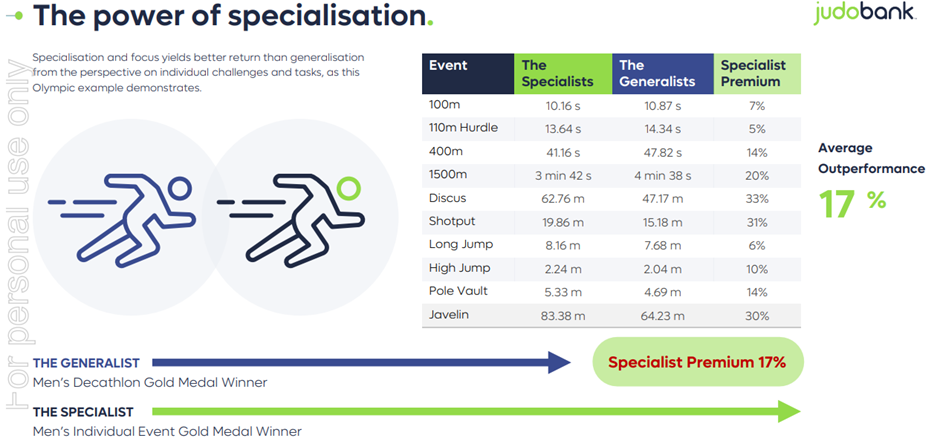
They believe the specialist focus gives them the opportunity to deliver the sorts of service, speed and availability that the competition can’t match.
That sounds like a slogan and no doubt a version of the same is plastered on the wall of all the big banks. I think the difference is in action though. Judo doesn’t seek to have the lowest cost base. In fact, at maturity they expect to have roughly twice the number of Relationship Bankers (RBs) per customers/loan values as their competition. RBs do not have individual sales targets and metrics measured include % time RBs spend on customer activities. RBs are given significant decision-making authority, including credit decisioning. Where decisions exceed their delegated authority the size of Judo is an inherent advantage in minimising delays, and this is likely to be the case well into the medium term.
That’s all very well but if their customers number one driver is cost, competing on service isn’t going to be winning strategy. Judo’s management believe pricing – while a factor – is not the prime consideration. This was an interesting slide from their prospectus which speaks to that (NPS=Net Promoter Score).
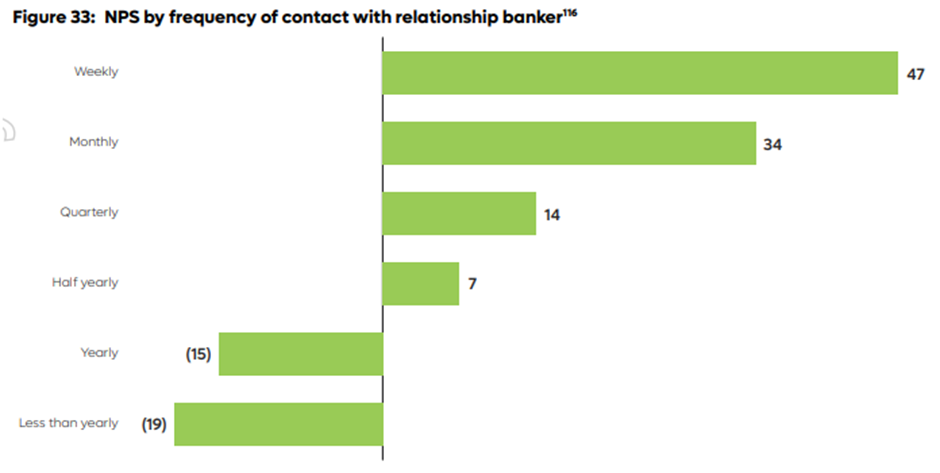
I think it makes sense from an economics perspective too. Individuals are likely to be much more price sensitive as they have limited ability to offset price in income. They might be able negotiate a salary increase, but usually only annually. More dramatic intervention might require changing jobs (which adds risk) or adding side hussles (which is a tradeoff). Whereas, businesses – even low margin ones – have the ability to offset at least some of their cost impacts by increasing prices.
Speaking of economics, it’s probably not a bad time to talk about the business economics.
Business Economics
Since coming to market the business has consistently reiterated the same metrics, which they believe they can achieve and are targeting at scale. These are:
- Loan book of $15-20 billion (currently $7.5b and forecasting $9b by June)
- Net Interest Margin exceeding 3% (currently exceeding this)
- Cost to Income ratio (CTI) approaching 30% (currently about 55% - given investment in FY23 it probably won’t drop much below that until next FY)
- Permanent loan book impairment of 0.5% per annum (so far they’ve only had two write-offs in their history for a total of $5.3 million. None in 1H FY23)
- Return on Equity of low to mid-teens, which for a bank is world leading ROE (they did 2.5% in 1H – unannualized - and have guided to low to mid-single digits for the full year)
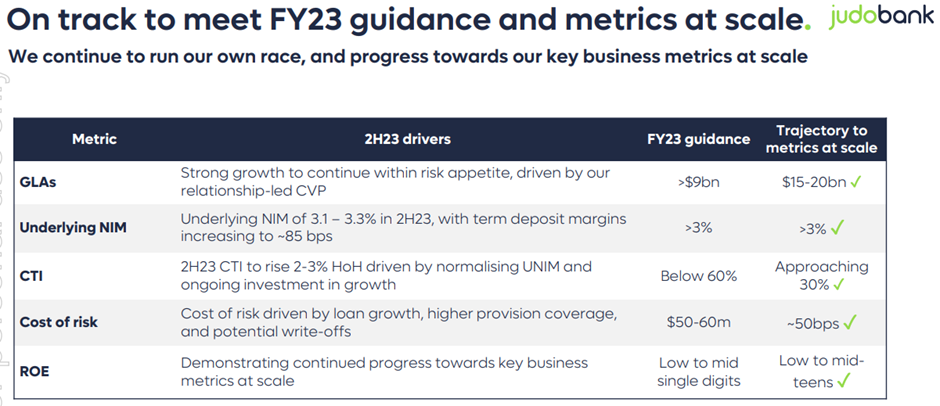
Arguably the most challenging of these metrics is a Cost to Income ratio of around 30%. That is significantly lower than their peers even though Judo doesn’t aspire to be a low-cost bank. However, they make the point that if you were to adjust the denominator instead of the numerator to allow for a 3% NIM, then their peers would have a CTI approaching 30%.
The NIM and ROE targets are really interesting. We’re consistently told Australia’s banks are the best there is and statistically there seems to be some truth in that. But the Big 4 struggle to get their NIM above 2% and ROE into double digits (CBA is best of these at 12%). The fact Judo already has a NIM over 3% and ROE heading in the right direction is encouraging.
What’s a little less encouraging is plugging those assumptions into a model suggests they need to hit the upper end of all those assumptions to achieve the ROE and the model is fairly sensitive to changes in any of the assumptions. The denominator value is a bit of an unknown – I’ve gone with an equity balance of $1.7 billion versus $1.4 billion currently.
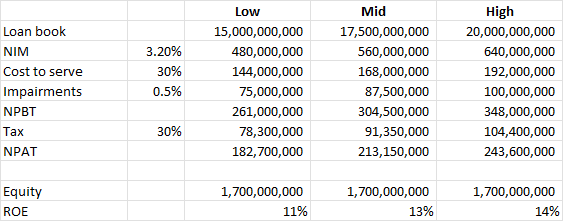
The other big unknown is the impact of the unwind of the RBA’s Term Funding Facility (TFF), which is one of the reasons why they’ve been able to so quickly achieve their NIM target. I’ll address this now.
What is the TFF?
The TFF gets 218 mentions in Judo’s prospectus reflecting its magnitude of importance (in contrast ‘shareholder(s)’ gets 139 mentions so go figure). The TFF was rolled out in March 2020, as a response to COVID, to encourage lending to Australian businesses. It was available for all business lending but had some incentives specifically for SME lending. Clearly this was right in Judo’s wheelhouse. In simple terms it allowed banks who loan to businesses to borrow from the RBA at a fixed rate of 0.10% until 30 June 2024. Pretty good deal and as a result Judo filled their boots.

The problem is what happens when it’s gone? Not only are the banks facing their own funding cliffs but some are arguing that the bigger banks will try to use their superior balance sheets to initiate a price war and squeeze out some of the smaller players. Even if they don’t I struggle to believe SMEs will be able to absorb a 300bps+ increase to rates overnight. The good news is that’s the worst case scenario and it won’t be anything like that bad. The TFF is only one of Judo’s funding sources, albeit a significant one, plus the unwind will be gradual, plus Judo has room to lower their NIM, plus they’ll look to increase margins from other funding sources like deposits. Still, it’s a risk worth noting.
Other risks
Speaking of deposits, Judo’s goal is to fund 70-75% of lending from deposits. I imagine in the past few weeks there’s been many a Board/CEO asking their CFOs to assess the concentration risk of their deposits and reduce accordingly. On the other hand, the Fed’s response to SVB and SB has exposed the policy of capping deposit guarantees for the fig leaf it is. On balance I suspect it’s not going to be an existential risk in the long term, but in the short term it may have an impact and I suspect that’s a major reason the share price has suffered in recent weeks.
The other major risk is we’ve yet to see a complete credit cycle for Judo. You probably have to go back to the early 1990s see a significant impairment event across the Australian business lending segment but when it happens it’s significant.
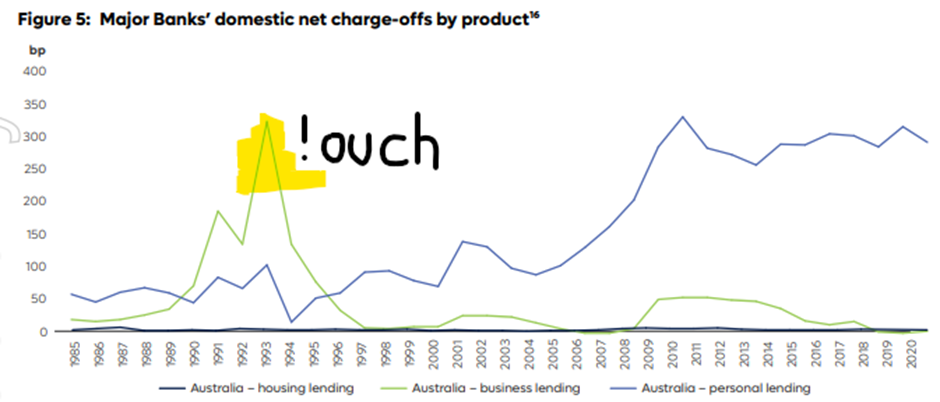
Management
They seem to be pretty decent with lots of ex-NAB and ANZ execs. CEO Joseph Healy with 35+ years in banking was former CEO of NAB’s Business Banking division. Joseph is a co-founder of the business. Deputy CEO and now Chief Relationship Officer Chris Bayliss also with 35+ years in banking held exec positions with NAB and several other banks in multiple geographies. Chris was the CFO but was moved to fill a perceived weakness in the leadership of the business. The new CFO is Andrew Leslie with 15+ years experience in banking, most recently at Morgan Stanley. Being a bank the Chief Risk Officer Frank Versace also needs a mention with 20+ years experience and prior roles at ANZ and Macquarie. The Board is Chaired by Peter Hodgson with prior roles at Bank of America and ANZ.
Insider ownership is well under 10%, which is not high for a founder-led business but is high relative to its peers. Incentives do have equity elements and include hurdles such as continued employment and performance versus budgets.
For what it’s worth their briefings do seem to be pretty open and transparent. There’s not a lot of question dodging or tangential speak. At their last Investor Day (next one is due in a couple of months) there was the opportunity to hear from and ask questions of all senior management rather than just the usual suspects.
More info
If interested I’d recommend the following:
Celeste Funds Management research note
The Call #2 (I just realised @Strawman was on this one and adjusting for the bank discount he was practically giddy!)
[Holding about 2% here and IRL]
Risks
· Compliance and regulatory risks - banking industry is highly regulated
· Competition - Australian banking system is dominated by the 4 major banks
· Customer default and portfolio performance
· Access to and cost of, funding
· Information technology, cybersecurity and data risks
· Reliance on outsourced service providers
· Retention of key management or employees
· Reputation risk
Judo is a recent IPO, it is Australia’s only bank dedicated exclusively to lending to Small and Medium Enterprises (SMEs). It was co-foundered by current CEO Joseph Healy and Chris Bayliss (Deputy CEO and CFO) and commended operations in March 2018. It IPO November 2021.
Judo currently has a loan book of approx $5 billion of which $4 Billion has been accumulated throughout the Covid-19 pandemic. Judo has set a medium to long term target of growing its loan book to $15 -$20 Billion which will represent approxmatelty 3 percent market share. Judo targets high quality SMEs with leading generally with following criteria:
· with annual turnover of up to $100 million
· located within a 200-kilometre radius of Australia’s capital cities and major regional centres
· with aggregated group loan exposures between $250,000 and up to $25 million
· with operations across a variety of industries (currently excluding agriculture)
Judo generates revenue through receiving gross interest on lending products, establishment and facility fees, interest generated on holding liquid assets and other operating income. Its targeting net interest margins of >3%. The Australian business lending market is dominated by the major banks accounting for 69% of all business leading while the combination of Macquarie Bank, ING Bank and the Regional Banks accounts for approximately 8% of all business lending.
Released January loan book numbers and are up to 4.96 billion. An increase of 0.11 billion from December, I imagine Dec/Jan are probably two of the slowest months to write new buisness loans. To mete their target of 6 billion by end of Fy22 they will need to average 0.21 billion/month for the rest of the year. Good growth from a low base currently.

The first new bank to list on the asx in 25 years, they listed in November last year called Judo bank. It is an interesting business that looks to be getting back to what bankers used to be focused on. Their strategy is focused on SME business loans and building the relationship between the banker and the business. Each banker currently services around 20 clients compared to 80-100 for the big four.
key points-
- only focused on business loans no exposure to the housing market apart from when it is linked to the business loan
- they take term deposits (11500 customers currently)
- the big four have neglected/abused this market
- their NPS score is 85 vs minus 7-10 for the best big bank in this SME segment
- customer service and flexibility is more important to the SME market than getting the lowest rate interest rate.
- November loan book at 4.67 billion, up from 3.52 at the end of June 21, target of 6 billion by end of FY22
- focus on growing loan book and reinvesting earnings, no dividend will be paid for many years.
- New loans sourced direct (23%) and through a select network of brokers (900 brokers) but aim to increase direct source loans to 50% over the next five years. Brokers get 10% commission.
- Loans generally secured against property.
- focus on lending to quality operators rather than quantity, they say they won’t lend to dodgy dudes.
- Total addressable SME business loan market is 605 billion, they are aiming for a 3-5% share over the medium/longer term
- arrears are low- only 2 customers overdue by more than 90 days, reflects their focus on quality loans
An interesting opportunity in the banking space, I am not really that interested in owning the big four but this one has piqued my interest in the focus on quality and being the best bank in their sector, they still have some growing to do and I will be watching their loan book and half year numbers. I have not bought yet and still thinking about how to value this business but could be a complimentary addition to the portfolio.